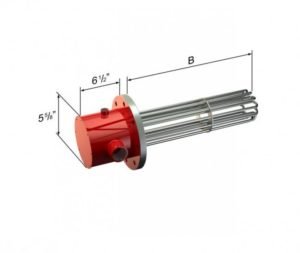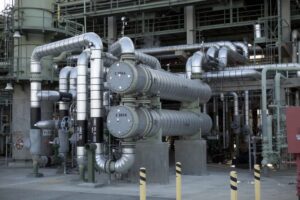Flanged Immersion Heaters in the Petrochemical Industry
Last updated on November 13th, 2023 at 07:20 pm
 Flanged heaters are commonly used for heating a variety of gases and liquids. These include heat transfer fluid, corrosive solutions, oil, and even water. These industrial oil heaters are designed for use in tanks and pressurized vessels. These can be pretty easy to install and maintain. Also, since flanged immersion heaters use the direct immersion method to heat, they are also more energy efficient, and better controlled.
Flanged heaters are commonly used for heating a variety of gases and liquids. These include heat transfer fluid, corrosive solutions, oil, and even water. These industrial oil heaters are designed for use in tanks and pressurized vessels. These can be pretty easy to install and maintain. Also, since flanged immersion heaters use the direct immersion method to heat, they are also more energy efficient, and better controlled.
Design Configuration of a Flanged Heater
Flanged immersion heaters are made up of bent, “U” shaped, tubular elements brazed or welded into a pipe flange and supplied with wiring boxes for electric connections. Flange is simply the disc-shaped rim that allows for one object to be attached to another one. Flange heaters are bolted to a matching flange, welded to the tank wall. These matching flanges can be as big as 24 inches. These can be both, round flange or square flange models, depending on the requirement of wattages and applications. The material sheaths for Flanged immersion heaters needs to be chosen based on the corrosiveness of the solutions they’ll be immersed in. These sheath materials include copper, steel, stainless steel, Incoloy™, and Teflon™. PTFE coatings are also available and can be rated for up to 600 lbs. A wide range of flange sizes, kilowatts, voltages, and materials, makes Flanged Immersion Heaters perfect for many types of heating purposes.
Uses & Applications in Petrochemical Industry
Flanged Immersion Heaters are used in oil rich areas like Houston Texas and North Dakota for a number of high-pressure applications. In fact, these are one of the most extensively used heating appliances in the oil and petrochemical sector. In addition to being quite easy-to-install, these heaters are specially designed for pressurized vessels for preheating oil, tanks clean-ups and heat transfers. The chief role of flanged immersion heaters remains in process heating, i.e. heating gas and liquids in containers and tanks because these respond well to the direct immersion method.
How to Select the Right Flanged Immersion Heaters
 It is very important to select the right immersion heater depending on the application needs. This means considering the heat requirements and electrical power requirements to get the job done on time, while also taking into account properties of the materials to be heated. So for example, crude petroleum oil requires a very low-watt density because it is quite dense in itself. The watt-density requirements will depend on how viscous and thermally conducive an oil or chemical is. So all in all, the right election of flanged heater depends upon:
It is very important to select the right immersion heater depending on the application needs. This means considering the heat requirements and electrical power requirements to get the job done on time, while also taking into account properties of the materials to be heated. So for example, crude petroleum oil requires a very low-watt density because it is quite dense in itself. The watt-density requirements will depend on how viscous and thermally conducive an oil or chemical is. So all in all, the right election of flanged heater depends upon:
- Heat requirements i.e. watt density and voltages,
- Type of fluid to be heated i.e. water or corrosive solutions, their viscosity, specific density and corrosive properties
- Presence of contaminants in the fluid, if any.
- Corrosion resistance powers of the sheath material.
- The kilowatt ratings, terminal enclosures as well as the size sheath materials of the flange.
It really depends on the process engineer to select and install a flange heater that is optimal for the job at hand. The design of a Flanged Immersion Heater can also play a very important role in ensuring that coking stays at a minimum or is prevented completely. Ilan Toledano is the Vice President of Marketing and Sales, North America, at Wattco, Quebec, Canada, a maker of electric heating elements and controls. To learn more from Wattco, call (800) 492-8826 or visit www.wattco.com.
